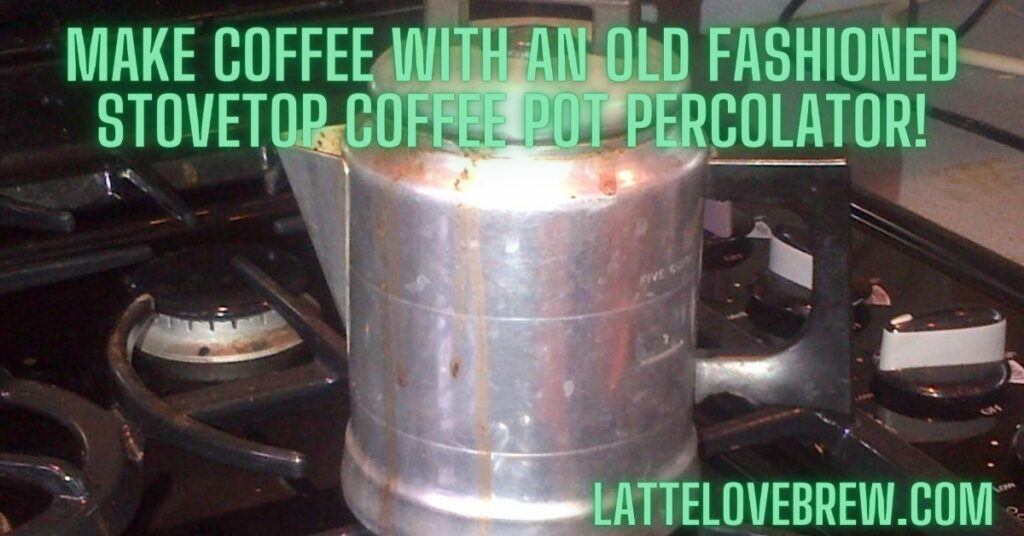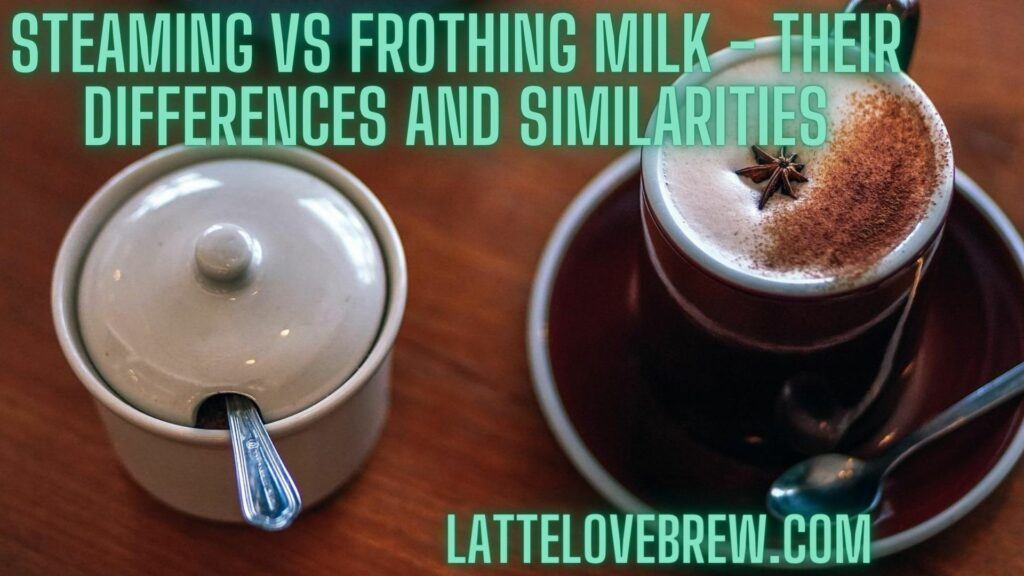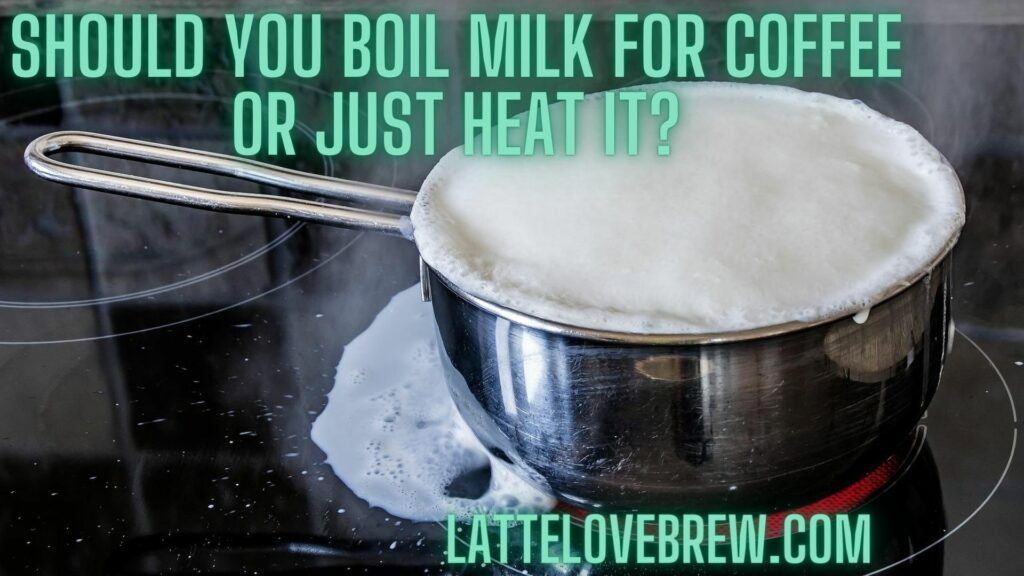Last updated on November 13th, 2023 at 14:18
Time to go old school and make coffee with an old-fashioned stovetop coffee pot! The crazy news is that old-fashioned stovetop coffee percolators are making a comeback, but still, coffee experts and coffee enthusiasts still think of using a percolator as an awful way to brew coffee.
Are they right? Or are they wrong?
Don’t knock it until you try it, I say!
How To Use An Old-Fashioned Coffee Percolator – Brewing A Cuppa With An Old Fashioned Stovetop Coffee Pot
Table Of Contents
- 1 How To Use An Old-Fashioned Coffee Percolator – Brewing A Cuppa With An Old Fashioned Stovetop Coffee Pot
- 2 Frequently Asked Questions About Old Fashioned Stovetop Coffee Pot
- 3 What Is A Stove Top Coffee Pot Called?
- 4 What Is An Old Coffee Pot Called?
- 5 Frappé-Ing It All Up! – Old Fashioned Stovetop Coffee Pot
Using an old-fashioned coffee percolator is very easy and, unlike its more modern counterparts, is a very hands-on coffee brewing method. Perhaps that is why it went out of fashion in the first place!
Let’s get down to brewing an old-fashioned coffee with a very retro-looking piece of equipment.
What Equipment Will You Will Need?
You will need the following:
- Fresh coffee grounds or fresh coffee beans.
- Measuring spoons and cups, optional and much better coffee scales.
- A stove
- A percolator, best an old-fashioned percolator, your favorite stovetop coffee brewer will do.
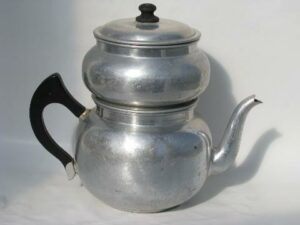
Read: Can you put a coffee pot on the stove
Let’s Get Brewing
Let’s get you making and brewing a cup of coffee, old school style, and enjoying an old-fashioned percolator coffee.
To make it best, use the best quality, the freshest possible water, be it mineral or spring water or good quality filtered water. Use the freshest possible coffee beans that are freshly roasted and freshly ground.
At Latte Love Brew we encourage you to control all the variables, measure and take note of everything. When you get into the habit of this, you will start making coffee that is consistently excellent. I encourage you to roast your own beans for maximum freshness with a home roaster.
Always grind your own beans right before you are about to use them.
Weigh and measure your water. Assume you are making a nice sized 24 ounce (720ml) of coffee, 3 x 8 ounce cups of coffee.
Grind and weigh 2 ounces (60 grams) of coarse ground coffee. If you are making a larger or smaller amount of coffee, stick to the 1:12 coffee to water ratio.
A larger 36 ounces of water (1080ml) will require 3 ounces (90 grams) of coffee grounds. If you are measuring by tablespoon, you will need 3 tablespoons of coffee for 24 ounces (720ml) of water and 4.5 tablespoons of coffee for 36 ounces of water.
You must absolutely use a coarse grind for your grounds. A larger grind size will take too long to brew, while too small a grind will make its way into the water, and you will end up with a gritty like brew and can end up as overtly bitter.
Grind your beans just as you are about to use them.
Now you are ready to start brewing. Add your water to the water chamber of your percolator. This water chamber. Make sure that you are adhering to the 1:12 coffee to water ratio, so your coffee is not too weak or too strong.
For you personally, and your own taste, you may need to adjust this to a higher 1:15 (weaker brew) or stronger 1:8 ratio. This is why we weigh our water and our grounds. Taking note you will have a record of what you like strength wise.
Now add the tube and coffee chamber.
Most old-fashioned stovetop coffee pot percolators work in the same way with a tube which functions as a valve that your water passes through and on to the grounds. Now add your measured coffee grounds into the coffee grounds basket and put the coffee basket into its place.
Trust the brewing ratios. If your coffee basket looks empty, don’t worry. Percolated coffee tends to be strong.
Time to now percolate. Place your percolator on your stove at a medium heat and slowly heat your water. Slowly is key, not quickly. Don’t try to accelerate the process. If you heat your water too quickly, it will boil. You don’t want to boil your water.
You want your water to reach a point where it is almost boiling and simmers nicely at a high temperature.
Monitor and listen for your coffee to make that classic and famed spluttering sound that a percolator makes. The spluttering sound is an indication that your percolator is at the right temperature and your coffee is brewing.
If the spluttering is too quick, your water is at too high a temperature, and you will need to reduce the temperature. Allow your coffee to percolate for between 5 mins to 10 minutes depending on how you like your coffee. If weaker coffee is what you like, then let it percolate for less time like 5 minutes or 6 minutes. If you want a stronger coffee, let it brew for a longer period of time.
When your coffee is ready, turn off the heat and take it off your stove. Remove the coffee basket. Removing the coffee grounds stops your coffee from over brewing if you want to heat it up later and from spilling into your coffee cup later when you are pouring.
That is it, serve and enjoy your coffee.

Read: How to clean a stainless steel percolator coffee pot
Frequently Asked Questions About Old Fashioned Stovetop Coffee Pot
How Old Is The Percolator?
The humble coffee percolator dates back to 1889 and Hanson Goodrich, an Illinois farmer. The patent filed by him contains all the recognizable items of a percolator, the central tube valve, the coffee basket, and water chamber.
How Did People Make Coffee In The Old Days?
Back in Yesteryear, coffee shops brewed coffee in coffee pots in a very basic manner, complete with the grounds. According to historians, the first filter used was a humble sock where hot water was poured over grounds in the sock. The water would then run through the grounds and eventually drip out the bottom.
A pour over drip coffee old school!
Coffee grounds, historically speaking, were roasted in a skillet over an open fire. If one bean, just one bean burned your whole batch was ruined! Back then there were no roasters!
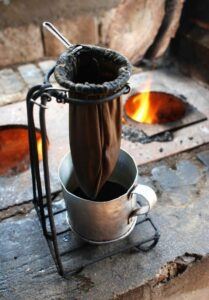
Why Have Percolators Become Less Popular?
There are a number of reasons why there has been a decline in percolated coffee. Back in the late 80s and 90s percolated coffee was the main go to for coffee shops and middle class homes.
Now, with advances in technology such as Nespresso and a reduction in price and the slight miniaturization of espresso machines from coffee shops and hotel bars to home kitchen counter size, there is less demand for what is seen as an ordinary coffee.
An increase in the popularity and the increase in the quality of coffee and a new 3rd wave of coffee has brought the French press coffee machine, Chemex Pour Over coffee, siphon vacuum coffee and other amazing coffee brewing techniques to be more common place. The old-fashioned coffee percolator and office drip has lost out.
It is very ordinary, unfashionable. People want something different and more flavorful. Percolator coffee was popular back in the day long before Starbucks and Costa Coffee and other such places came about.
What Is A Stove Top Coffee Pot Called?
There are two types of stove to coffee pots, a percolator, which you are perhaps familiar with and a moka pot. A moka pot looks like a mini percolator but don’t let looks fool you as moka pot does not percolate coffee. The coffee passes up through the bed of coffee but does not percolate; it remains there in the coffee chamber.
Although the moka pot is a stovetop coffee maker there are modern electric versions which are becoming popular. Still, the humble moka pot serves its advantage as it can be taken on a camping trip.
What Is An Old Coffee Pot Called?
Both a coffee percolator and a moka pot can be considered as an old coffee pot. The percolator, more popular in the UK and America, while in continental Europe, the moka pot is king, and still is! You’ll find one in every home in Southern Europe.
Do Stove Top Coffee Makers Make Good Coffee?
Yes, stove top coffee makers make good coffee, particularly when you use a good dark roast coffee. In my opinion and taste preference, a stove top moka pot makes better coffee than a stove top percolator.
Why Did Percolators Go Out Of Style?
Percolators went out of fashion with the invention and introduction of drip coffee makers and improved manufacturing techniques for instant coffee.
How Long To Percolate Stovetop Coffee?
The ideal amount of time to percolate your stovetop coffee is 7 to 10 minutes depending on how strong you want and like your coffee.
Frappé-Ing It All Up! – Old Fashioned Stovetop Coffee Pot
Old fashioned stovetop coffee pot and percolator coffee is nice to enjoy when you are working from home or studying and having it percolating away staying forever warm (be sure to remove the grounds) all day long. Don’t expect a spectacular coffee from it, no matter what beans you use as this method is not the greatest for extracting the full flavors and does deliver a strong coffee.
Still, don’t knock it! One of my go to’s when I am busy and need a good caffeine kick.
Join our vibrant and active online coffee community on Facebook/Meta and share your fabulous and tasty coffee creations, recipes and funny coffee memes, jokes and if you want, a nice smiley coffee morning selfie.

